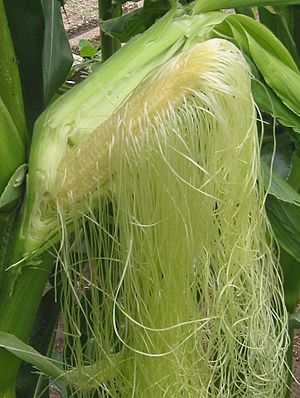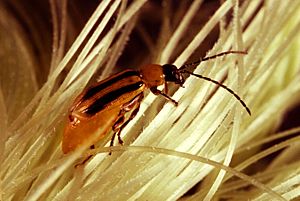Corn silk facts for kids
Corn silk is the soft, thread-like "hair" that you see on an ear of corn. It's made of many thin fibers that stick out from the top of the corn cob. Each fiber is like a tiny tube that connects to a potential corn kernel inside the ear. These fibers are important for the corn plant to make new kernels. The word "corn silk" has been used since the mid-1800s.
How Corn Silk Grows
Inside each ear of corn, there can be up to 1,000 tiny parts that could become corn kernels. Each of these parts grows its own strand of corn silk. These silk strands grow longer and eventually poke out from the end of the corn ear.
When at least one silk strand appears from an ear of corn, it means the plant has reached a special growth stage. The silk grows quickly, about 1.5 inches each day at first. It keeps growing for about 10 to 14 days before it fully emerges.
The silk stops growing soon after it catches a grain of pollen. It also stops growing if it gets too old, usually about 10 days after it first appears.
If a corn kernel is successfully fertilized by pollen, the corn silk connected to it will fall off a few days later. If it's not fertilized, the silk stays attached. This means farmers can gently check corn ears to see how well the pollination is going by shaking them and seeing how much silk falls away.
What Corn Silk Does
Corn silk acts like the female part of the corn flower. Its main job is to catch pollen grains. The very tip of the corn silk has tiny hairs that help pollen stick to it.
For a corn kernel to form, pollen needs to land on the corn silk. This usually happens when wind or insects carry pollen from other corn plants. Even if many pollen grains land on the silk, only one will successfully fertilize a kernel.
Once a pollen grain lands on the silk, it grows a tiny tube called a pollen tube. This tube grows down the length of the corn silk strand, reaching the potential kernel inside. This process is how the corn plant's genetic material gets to the kernel, allowing it to grow. Usually, 400 to 600 kernels successfully form on an ear of corn this way. The pollen tube grows very fast, about 1 centimeter per hour. It can create a foot-long path in just 24 hours!
Some types of corn, like popcorn, have a special way to control which pollen they accept. They can slow down pollen tubes from other types of corn that don't match them closely. This helps them keep their unique traits.
Corn Silk and Insects
Sometimes, insects are attracted to the fresh, moist corn silk. They might chew on the silk, which is called "silk clipping." If too much silk is clipped, it can make it harder for the corn kernels to form properly.
Uses of Corn Silk
Corn silk has been used in traditional medicine for a long time. It contains different natural compounds that are thought to be good for health.
For example, corn silk is sometimes used as a diuretic, which means it helps the body get rid of extra water. It's also been studied for its ability to help with high blood sugar and to act as an antioxidant, which protects cells from damage. You might find corn silk in teas or health supplements, often used for helping with urinary problems.
See also
 In Spanish: Barba de maíz para niños
In Spanish: Barba de maíz para niños




